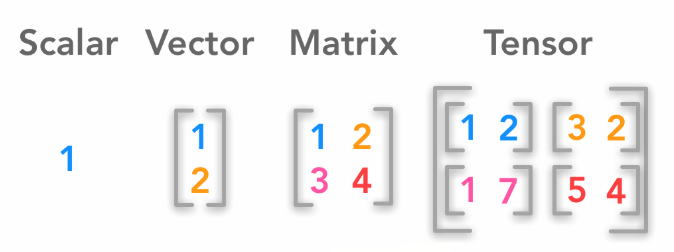데이터 단위

- 스칼라 - 차원이 없는 값
- 벡터 - 1차원 텐서
- 메트릭스 - 2차원 텐서
- 텐서 - 3차원
텐서 크기 구하기
2차원 텐서 크키 = batch size x dim
3차원 비전 텐서 크기 = batch size x dim x height
3차원 nlp 텐서 크기 = batch size x length x dim
Tensor Manipulation
1D tensor with Pytorch
1차원 텐서의 dim, shape, size, Slicing
t = torch.FloatTensor([0., 1., 2., 3., 4., 5., 6.]) print(t.dim()) # rank # 배열의 차원 수 or 배열의 축 수 print(t.shape) # shape # 텐서의 크기 print(t.size()) # shape와 같음 print(t[0], t[1], t[-1]) # Element print(t[2:5], t[4:-1]) # Slicing print(t[:2], t[3:]) # Slicing
1
torch.Size([7])
torch.Size([7])
tensor(0.) tensor(1.) tensor(6.)
tensor([2., 3., 4.]) tensor([4., 5.])
tensor([0., 1.]) tensor([3., 4., 5., 6.])2D tensor with PyTorch
2차원 텐서의 dim, shape, size, Slicing
t = torch.FloatTensor([[1., 2., 3.], [4., 5., 6.], [7., 8., 9.], [10., 11., 12.] ]) print(t.dim()) # rank print(t.size()) # shape print(t[:, 1]) print(t[:, 1].size()) print(t[:, :-1])
2
torch.Size([4, 3])
tensor([ 2., 5., 8., 11.])
torch.Size([4])
tensor([[ 1., 2.],
[ 4., 5.],
[ 7., 8.],
[10., 11.]])Broadcasting
same shape
m1 = torch.FloatTensor([[3, 3]]) m2 = torch.FloatTensor([[2, 2]]) print(m1 + m2)
tensor([[5., 5.]])Vector + Scalar
m1 = torch.FloatTensor([[1, 2]]) m2 = torch.FloatTensor([3]) # [[3, 3]] print(m1 + m2)
tensor([[4., 5.]])2 x 1 Vector + 1 x 2 Vector
m1 = torch.FloatTensor([[1, 2]]) # [[1, 2], [1, 2]] m2 = torch.FloatTensor([[3], [4]]) # [[3, 4], [4, 4]] print(m1 + m2)
tensor([[4., 5.],
[5., 6.]])Multiplication vs Matrix Multiplication
곱셈(.mul)
m1 = torch.FloatTensor([[1, 2], [3, 4]]) m2 = torch.FloatTensor([[1], [2]]) print('Shape of Matrix 1: ', m1.shape) print('Shape of Matrix 2: ', m2.shape) print(m1 * m2) # m2를 [[1, 1], [2, 2]]로 broadcasting print(m1.mul(m2)) # m2를 [[1, 1], [2, 2]]로 broadcasting
Shape of Matrix 1: torch.Size([2, 2])
Shape of Matrix 2: torch.Size([2, 1])
tensor([[1., 2.],
[6., 8.]])
tensor([[1., 2.],
[6., 8.]])행렬곱셈(.matmul)
m1 = torch.FloatTensor([[1, 2], [3, 4]]) m2 = torch.FloatTensor([[1], [2]]) print('Shape of Matrix 1: ', m1.shape) # 2 x 2 print('Shape of Matrix 2: ', m2.shape) # 2 x 1 print(m1.matmul(m2)) # 2 x 1 #일치하는 행이 사라짐
Shape of Matrix 1: torch.Size([2, 2])
Shape of Matrix 2: torch.Size([2, 1])
tensor([[ 5.],
[11.]])Mean
t = torch.FloatTensor([1, 2]) print(t.mean()) t = torch.LongTensor([1, 2]) try: print(t.mean()) except Exception as exc: print(exc)
tensor(1.5000)
Can only calculate the mean of floating types. Got Long instead.
You can also use t.mean for higher rank tensors to get mean of all elements, or mean by particular dimension.t = torch.FloatTensor([[1, 2], [3, 4]]) print(t.mean()) print(t.mean(dim=0)) # 1 x 2 print(t.mean(dim=1)) # 2 x 1 print(t.mean(dim=-1))
tensor(2.5000)
tensor([2., 3.])
tensor([1.5000, 3.5000])
tensor([1.5000, 3.5000])Sum
t = torch.FloatTensor([[1, 2], [3, 4]]) print(t.sum()) print(t.sum(dim=0)) print(t.sum(dim=1)) print(t.sum(dim=-1))
tensor(10.)
tensor([4., 6.])
tensor([3., 7.])
tensor([3., 7.])Max and Argmax
t = torch.FloatTensor([[1, 2], [3, 4]]) print(t.max()) print(t.max(dim=0)) print('Max: ', t.max(dim=0)[0]) print('Argmax: ', t.max(dim=0)[1]) print(t.max(dim=1)) print(t.max(dim=-1))
tensor(4.)
(tensor([3., 4.]), tensor([1, 1])) # index값 같이 리턴
Max: tensor([3., 4.])
Argmax: tensor([1, 1])
(tensor([2., 4.]), tensor([1, 1]))
(tensor([2., 4.]), tensor([1, 1]))